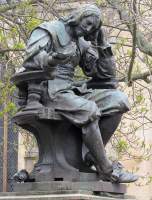 H. A. Pegram's Sir Thomas Browne.
H. A. Pegram's Sir Thomas Browne.
 H. A. Pegram's Sir Thomas Browne.
H. A. Pegram's Sir Thomas Browne.
The central square or Market Place in Norwich is occupied by the covered market, and dominated on its more elevated, western side by the 1930s City Hall, and on the left as you face the City Hall is the large church of St Peter Mancroft. There is an important bronze statue at the foot and extension of the square at the rear of the church, Sir Thomas Browne, by the sculptor Henry A Pegram – it is signed and dated 1905. The plinth describes the subject as ‘physician and philosopher’, and his time was of the 17th Century. He is shown seated, resting on one elbow and contemplating a broken, ancient shard of pottery. His clothes are flamboyant, his hair and moustache rather Shakespearian, and altogether he presents a noble and heroic aspect. His chair is a somewhat heavy baroque thing, almost a throne. The monument to Thomas Browne is in the church.
The sculptor, Henry A Pegram, is not so well known today, and is sometimes confused with the not particularly better known Bertram Pegram. The rather excellent Thomas Browne statue is one of his best. He has a second work in Norwich, the Edith Cavell monument in Tombland, with a bronze bust on a tall stone plinth, which has attached to it a statue of a soldier reaching up to grasp one of two rings, or wreaths, an unusual composition.
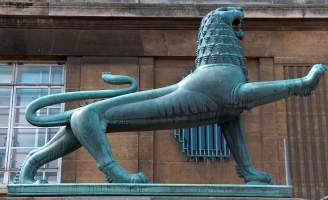 One of two bronze lions by Alfred Hardiman.
One of two bronze lions by Alfred Hardiman.
The other significant sculpture in the square consists of the two bronze lions in front of the City Hall – they are very much of their period, and are the work of Alfred Hardiman. These deco beasts have a definitely Assyrian origin. On the rear of the building are three stone statues by Hardiman against the rather plain wall. They consist of a tall, Moses-like figure with a heavy beard, holding an owl, and with medieval flowing drapery in a style occasionally favoured by Burne-Jones, flanked by two Graeco-female figures, each with a naked infant. The patriarch is representative of Legislation, and his companions are Recreation (holding a ball), and Education (unrolling a scroll), thus showing some of the important ambits of the local council (for a note on allegorical representation of Education see this page, and for Recreation, see this page). The bronze doors of the building have roundels with low relief scenes of activities associated with Norwich, by the sculptor James Woodford. The City Hall itself is the work of the architects C. H. James and S. R. Pierce, and was put up in 1932-38 - Pevsner refers to it as 'likely to go down in history as one of the foremost English public buildings of between the wars'. The interior, however, is grimly rather than grandly municipal and consists mostly of an endless series of Orwellian corridors.
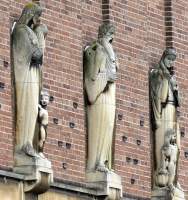 Recreation, Legislation, Education; by Alfred Hardiman.
Recreation, Legislation, Education; by Alfred Hardiman.
On the side of the building are a rather crude version of the City coat of arms, flanked by two angels in high relief, in a very stylised, harsh idiom. I do not know if these too are by Hardiman – if so, they are atypical of his other work that I have seen.
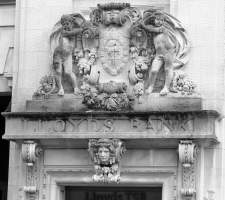 Lloyds Bank doorway sculpture.
Lloyds Bank doorway sculpture.
On the Eastern side or base of the square, away from the City Hall, is a large and impressive branch of Lloyds Bank, with its corner and side entrances bearing large cartouches with the Lloyds symbol of the prancing horse, held by flanking pairs of cherubs; below these and above each door is a keystone head, nice art nouveau things, one slightly smiling, the other frowning. Various festoons and bunches of flowers and fruit also adorn the building, and on the top is a panel of crossed arms etc with a central snarling lion’s head. Also on this side, not at all indicative of what lies within and at the other end, is one end of the Arts and Crafts Royal Arcade, by the Norwich architect Skipper.
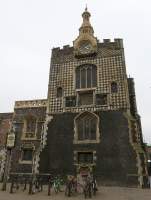
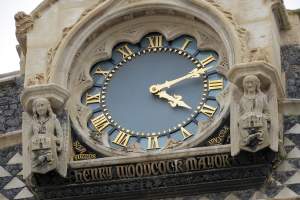 Norwich Guildhall, and 19th Century angels.
Norwich Guildhall, and 19th Century angels.
On the right hand side of the Market Place, to the North, is the medieval Guildhall, built at the beginning of the 15th Century, and covered with knapped flint and stone in a chequered pattern, a noble building but now completely exposed and dwarfed by the square and the Town Hall. At the end, the small 19th Century Gothic clock tower bears a pair of half angels (one badly restored), holding shields showing a lion and medieval castle. Between them, an attribution to Henry Woodcock, Mayor. Lower down are two small plaques, each with a pair of standing figures, one pair with apparently a knight’s helm on a short pillar, the others holding a shield. But these are so battered and ruined by time and soot that it is impossible to discern their quality. Little heads of kings on the window below must be further 19th Century work; round the other sides is further 19th Century decoration, including good angels over a door properly sympathetic to the older fabric of the building. Back to our end wall, at the base is a small fountain, presented by Charles P Melly in 1855, with a decayed surround to the granite basin, a recollection of less parsimonious times when the local councils supplied fresh water to the citizenry. The remaining pillars to the monument show twisted fluting and almost featherlike tops which may once have been acanthus leaves. No. 7 Guildhall Hill amost adjacent is a brown terra cotta effort with two little roundels of Caxton and Defoe.
Finally, dominating the side of the square is the Gothic bulk of St Peter Mancroft, which contains a variety of interesting wall monuments inside.
St Peter Mancroft // St John Timberhill and the Norwich sculptor Robert Page // St Michael at Plea // St John Maddermarket // Norwich Boer War Memorial
Visits to this page from 5 May 2012: 11,172